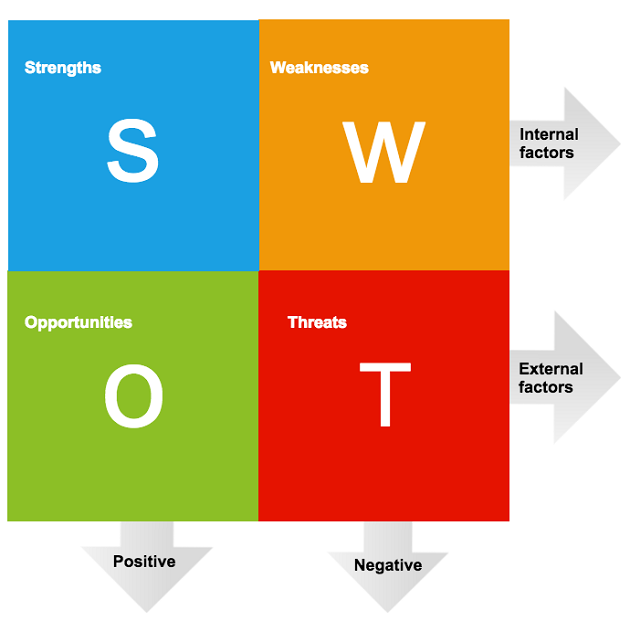A plan of action or policy designed to achieve a major or overall aim is what formulate your strategy wether in Military, Business, Marketing or, even a game.
Interesting Article ➤ Have you ever read about Apple’s core values?
Every Chief Marketing Officer or team looks over the findings and tailors a marketing plan, which she passes on to the advertising department or source so it can make a campaign for the product. If you’re a sole proprietor, the SWOT analysis is a a strategy development tool that can be helpful for not just your marketing plans but your business success altogether.
A,B,C Planning For Beginners ➤ How to create SMART goals
- Advertisement -
“So in war, the way is to avoid what is strong and to strike at what is weak. Water shapes its course according to the nature of the ground over which it flows; the soldier works out his victory in relation to the foe whom he is facing.” – Sun Tzu, ‘The Art of War’
SWOT Analysis Matrix:
SWOT analysis (alternatively SWOT Matrix) is a structured planning method used to evaluate the Strengths, Weaknesses, Opportunities, and Threats involved in a project or in a business venture.

In the business world, warfare concepts and tactical maneuvers is a commonly used and SWOT analysis technique created to simulate competitive intelligence and test the implementation of strategies to counter the competition. As Sun Tzu, [Author of The Art of War] said “To know your enemy, you must become your enemy.” i.e: to simulate the mindset and situation of one’s competitor so that strategies to counter the competition can be tested.
Techniques such as a SWOT analysis should be used for competitor benchmarking as some of the top types of competitive intelligence.
[S] For Strengths:
Two factors contribute to your strengths: ability and resources available.
Ability is evaluated on 3 counts:
1. Versatility: your ability to adapt to an ever changing environment.
2. Growth: your ability to maintain a continuing growth.
3. Markets: your ability to penetrate or create new markets.
The strength of resources has three dimensions:
1. Availability: your ability to obtain the resources needed.
2. Quality: the quality and up-to-dateness of the resources employed.
3. Allocation: your ability to distribute resources both effectively and efficiently.
[W] For Weaknesses:
Your weaknesses are determined through failures, defeats, losses and inability to match up with the dynamic situation and rapid change. The weaknesses may be rooted in lack of managerial skills, insufficient quality, technological backwardness, inadequate systems or processes, slow deliveries, or shortage of resources. There are three possible outcomes to the analysis of your weaknesses.
1. Correction of an identified defect.
2. Protection through cover-up and prevention strategies to reduce the exposure of your weaknesses.
3. Aggression to divert the attention from your weaknesses.
[O] For Opportunities:
Opportunities are abundant. You must develop a formula which will help you define what comes within the ambit of an opportunity to focus on those areas and pursue those opportunities where effectiveness is possible. The formula must define product/service, target market, capabilities required and resources to be employed, returns expected and the level of risk allowed.
Weaknesses of your competitions are also opportunities for you. You can exploit them in two following ways:
1. Marketing warfare: attacking the weak leader’s position and focusing all your efforts at that point, or making a surprise move into an uncontested area.
2. Collaboration: you can use your complementary strengths to establish a strategic alliance with your competitor.
[T] For Threats:
External threats arise from political, economic, social, technological (PEST) forces. Technological developments may make your offerings obsolete. Market changes may result from the changes in the customer needs, competitors’ moves, or demographic shifts. The political situation determines government policy and taxation structure.

What Is a Strength, Weakness, Opportunity and Challenge Analysis (SWOC)?
SWOC analysis is now defined as a strategic planning method used to research external and internal factors which affect company success and growth. Firms use SWOC analysis to determine the strengths, weaknesses, opportunities, and challenges of their firm, products, and competition.
“T” in SWOT changed to be “C” for SWOC
Because the term Threat is originated from military strategy, Using “C” as Challenge or Constrains is recommended to create more positive attitude.
Challenge is replaced to represent an obstacle that can be achieved and using the motivation mind set to overcome your competitor’s PowerPoint/s .
SWOT or, SWOC analysis still serving the same needs, However changing your team mindset while the strategic meeting would be very energetic to create more valuable results.
Also find some guidelines for your next SOWT/C analysis.

A realistic recognition of the weaknesses and challenges that exist for your effort is the first step to countering them with a robust and creative set of strengths and opportunities. A SWOC analysis identifies your strengths, weaknesses, opportunities and challenges to assist you in making strategic plans and decisions.
SWOT is a simple yet comprehensive way of assessing the positive and negative forces within and without your organization, so you can be better prepared to act effectively. The more stakeholders you involve in preparing the SWOT, the more valuable your analysis will be.
Whatever courses of action you decide on, the four-cornered SWOT analysis prompts you to move in a balanced way throughout your program. It reminds you to:
- Build on your strengths
- Minimize your weaknesses
- Seize opportunities
- Counteract challenges
A SWOC analysis will be most helpful if you use it to support the vision, mission, and objectives you have already defined. The SWOC will at least provide perspective, and at best will reveal connections and areas for action.
Thank you for reading and wish it was helpful 🙂








